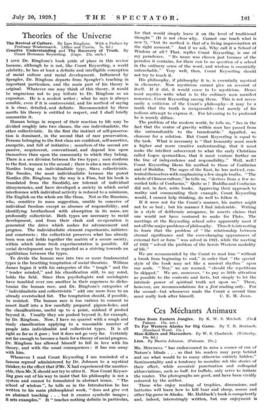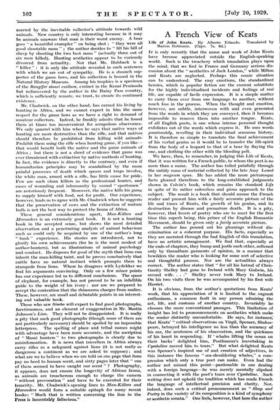Ces Mechants Animaux
To Far Western Alaska for Big Game. By T. R. Hubback. (Rowland Ward. I5s.) Lion. By Martin Johnson. (Putnam. 21s.)
MR. MITCHELL " has endeavoured to raise a corner of one of
Nature's blinds . . . so that his readers may peep behind and see what would be to many otherwise entirely hidden."
Sentimentality and a tendency to moralize rob the stories of their effect, while eccentric punctuation and colloquial abbreviations, such as buff. for buffalo, only serve to irritate the reader. The photographs are good, and have been vividly coloured by the author.
Those who enjoy reading of trophies, dimensions, and batteries will learn how to kill bear and sheep, moose and other big game in Alaska. Mr. Hubback's book is competently and, indeed, interestingly written, but our enjoyment is marred by the inevitable collector's attitude towards wild animals. New country is only interesting because in it may be animals unaware that man is their worst enemy. A bear goes " a beautiful crumpler " on being shot ; " they were all good shootable rams " ; the author decides to " fill his bill of sheep by shooting the two best rams " (actually three out of six were killed). Hunting aesthetics appear to be curiously divorced from actuality. Not that Mr. Hubback is a " killer " : it is only the attitude revealed in such sentences with which we are cut of sympathy. He is a staunch sup- porter of the game laws, and his collection is housed in the Natural History Museum. Among his trophies is a specimen of the Rangifer stonei caribou, extinct in the Kenai Peninsula but rediscovered by the author in the Rainy Pass country, which is sufficiently remote, we trust, to ensure its continued existence,
Mr. Chadwick, on the other hand, has earned his living by hunting in Africa, and we cannot expect in him the same respect for the game laws as we have a right to demand of amateur collectors. Weed, he frankly admits that he found them at times too inconvenient for scrupulous observance. We only quarrel with him when he says that native ways of hunting are more destructive than the rifle, and that natives should therefore be prohibited from killing wild animals. Prohibit them using the rifle when hunting game, if you like— that would benefit both the native and the game animals of Africa ; but there is not a shred of evidence that game was ever threatened with extinction by native methods of hunting. In fact, the evidence is directly to the contrary, and even if humanitarian principles may be scandalized by the more painful processes of death which spears and traps involve, the white man, armed with a rifle, has little cause for pride. Few are such clean killers as the professional hunter, and cases of wounding and inhumanity by casual " sportsmen '' are notoriously frequent. Moreover, the native kills his game to supply himself with food, not for profit. Our experience, however, leads us to agree with Mr. Chadwick when he suggests that the preservation of cows and the extinction of mature bulls is not the best way to protect the fauna of Africa.
These general considerations apart, Man-Killers and Marauders is an extremely good book. It is not a hunting book in the accepted sense, but shows the most detailed observation and a penetrating analysis of animal behaviour such as could only be acquired by one of the author's long " bush " experience. His stories are introduced, not to glorify his own achievements (for he is the most modest of author-hunters), but as illustrations of animal psychology and conduct. He disposes for good of the myth that lions can inherit the man-killing taint, and he proves conclusively that cattle have no natural instinct which prompts them to stampede from lions. Where he disagrees with Lydekker we find his arguments convincing. Only on a few minor points has our experience led us to different conclusions. The spoor of elephant, for example, has not proved to be an infallible guide to the weight of his ivory : nor are we prepared to accept the contention that the rhinoceros charges from malice. These, however, are small and debatable points in an interest- ing and valuable book.
Those who saw Simba will expect to find good photographs, facetiousness, and an element of exaggeration in Mr. Martin Johnson's Lion. They will not be disappointed. It is really a pity that such good photographs (though some of them are not particularly necessary) should be spoiled by an impossible
letterpress. The spelling of place and tribal names might with advantage have been more accurate, and the ascription of " Masai hunters " to two photographs is clearly due to misinformation. It is news that travellers in Africa always-
carry rifles as a safeguard against lions (it is not really so dangerous a continent as we are asked to suppose) ; and what are we to believe when we are told on one page that lions pay no heed to human scent, and sixty pages later that " one of them seemed to have caught our scent " ? Photography, it appears, does not ensure the longevity of African fauna, as animals are treacherous enough to charge the camera " without provocation " and have to be executed for their temerity. Mr. Chadwick's opening lines to Man-Killers and Marauders would form a suitable epitaph for many recent books : " Much that is written concerning the lion in the Press is lamentably fallacious."

















































 Previous page
Previous page